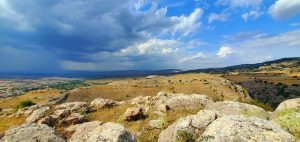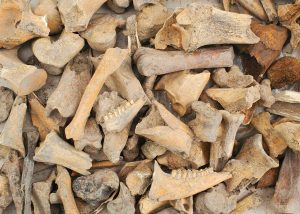
Christine A. Mikeska, daha önce yüksek lisans derecesini aldığı Chapel Hill’deki Kuzey Carolina Üniversitesi (UNC-CH), Antropoloji Bölümü’nde doktora adayıdır. Zooarkeoloji üzerine uzmanlaşan Mikeska, zooarkeolojinin geleneksel yöntemlerini izotop analiziyle birleştirerek insan-hayvan etkileşimlerini ve onları şekillendiren toplumsal ağları inceliyor. Doktora tez projesi, Orta ve Geç Tunç Çağı boyunca Boğazköy/Hattuşa kentinde karmaşık hayvan tedarik sistemlerinin gelişimine odaklanıyor. Mikeska, erken dönem kent ekonomisine dair geleneksel yukarıdan aşağı anlatıları karmaşıklaştıran çalışmasında, kentin çeşitli ihtiyaçlarını karşılayan birden çok, paralel hayvan ekonomisinin var olma potansiyelini ve Hattuşa’nın gelişerek Anadolu’nun ilk imparatorluğunun başkenti hâline gelmesiyle birlikte bu ekonomilerin ne şekilde değiştiğini araştırıyor. Tunç Çağı Anadolu’suna odaklanan doktora araştırmasının yanı sıra Mikeska İtalya ve Kıbrıs’taki arkeolojik kazılarda da çalışmış, Avrupa, Afrika ve Kuzey Amerika’daki sit alanlarından elde edilen arkeolojik faunal buluntu kümelerini analiz etmiştir.
Research Title: Feeding the City, Feeding the Gods: Animal Economies at Bronze Age Hattuša
Ms. Mikeska is a PhD candidate in the Department of Anthropology at the University of North Carolina at Chapel Hill (UNC-CH), where she also completed her Masters degree. Specializing in zooarchaeology, Ms. Mikeska combines the traditional methods of zooarchaeology with isotope analysis to investigate human-animal interactions and the social networks that structured them.
Her dissertation project focuses on the development of complex systems of animal provisioning at urban Boğazköy-Hattuša during the Middle and Late Bronze Ages. Complicating traditional top-down narratives of early urban economy, Ms. Mikeska investigates the potential for multiple parallel animal economies supplying the city’s diverse needs and the ways in which these economies changed as Hattuša developed into the capital of Anatolia’s first empire. In addition to her doctoral focus on Bronze Age Anatolia, Ms. Mikeska has also worked on archaeological excavations in Italy and Cyprus, as well as analyzed archaeological faunal assemblages from sites in Europe, Africa, and North America.
Fellow’s End of Academic Year Research Report:
Feeding the City, Feeding the Gods: Animal Economies at Bronze Age Hattuša
I was fortunate to be awarded an ANAMED PhD Fellowship to pursue my doctoral dissertation research during the 2021–2022 academic year. My research focuses on human-animal relationships and urban development at the Bronze Age city of Boğazköy-Hattuša, located in the modern province of Çorum, Turkey (Fig. 1). ANAMED’s generous funding has provided me the opportunity to analyze approximately 10,000 animal bones recovered during the 2015–2021 excavation seasons, undertaken by the German Archaeological Institute (DAI) with permission from the Turkish Ministry of Culture and Tourism. One of the largest and most significant urban centers in Bronze Age Southwest Asia, Boğazköy-Hattuša grew from an important regional center and local capital in the Middle Bronze Age (MBA, ca. 2000–1500 BCE) into the imperial capital of the Hittite Empire during the latter half of the Late Bronze Age (LBA, ca. 1500–1180 BCE). Throughout both the MBA and LBA, Boğazköy-Hattuša was home to a diverse population of workers, craftspeople, soldiers, administrators, priests, royalty, and the so-called “1000 gods of Hatti,” all of whom lived alongside an equally diverse population of domestic and wild animals. Within my dissertation, I argue that these animals, which ranged from livestock and other domesticates to wild game and even dangerous predators, were fundamental to the social organization and development of Boğazköy-Hattuša, impacting both the physical and social landscapes of the city through a wide variety of human-animal interactions.

Fig. 1. Boğazköy-Hattuša as seen from the Upper Town. Photo Credit: Christine Mikeska.
The primary research question of my doctoral dissertation asks how urban animal economies were structured at MBA and LBA Boğazköy-Hattuša and how these human-animal interactions impacted the development of the city and the Hittite state more broadly. Drawing together archaeological, textual, and iconographic evidence, I investigate the urban animal economies responsible for supplying Boğazköy-Hattuša’s numerous communities and institutions, the geographic scale of these interactions, and how economies changed over the course of the second millennium BCE as the city developed into the capital of Anatolia’s first empire. Within the scope of this project, I define “urban animal economies” as the multitude of human-animal interactions that take place within and around urban landscapes. With this definition in mind, urban animal economies impacted everything from subsistence (e.g., meat, dairy, and draft animals) and craft industries (e.g., fibers, leather, and glues) to essential services (e.g., protection, transportation, and waste management) and even the reinforcement of social ideologies and cosmological power structures (e.g., taboos, feasting, and rituals). My research seeks to highlight this multiplicity within the context of early cities, as well as the potential diversity of the systems and networks designed to manage these assorted and ubiquitous human-animal interactions.
To investigate these relationships and their overall impact on urban development at Boğazköy-Hattuša, I use the methods of zooarchaeology and the theoretical framework of social zooarchaeology. Zooarchaeology is the study of archaeological animal remains, which include materials like bones, teeth, and shells. When analyzing archaeological animal remains (Fig. 2), zooarchaeologists record features such element, species, age, sex, pathologies, fragment and element size, and cultural and environmental modifications, such as butchery, tool production, burning, or animal gnawing. Depending on the research questions, zooarchaeologists can also extract other types of data, like isotopes or DNA. Because animal remains are one of the most abundant categories of artifacts recovered during excavation, zooarchaeologists can use these data to investigate a wide range of questions about how humans used and related to animals in the past and the impacts of those interactions on human culture, the environment, and the animals themselves.

Fig. 2. Archaeological animal remains. Photo Credit: Christine Mikeska.
Social zooarchaeology,[i] which combines the methods of zooarchaeology and the theoretical discourse of anthropology and animal studies, takes this interpretative potential one step further by taking a holistic view of human-animal relationships and acknowledging that animals are entangled in all aspects of human society, both directly and tangentially. Therefore, animal remains can be used to answer interpretative questions that contribute to larger archaeological dialogues. While social zooarchaeology has been influential in the study of prehistory, it has been slow to be incorporated into the study of urban assemblages. Nevertheless, social zooarchaeology has great potential to contribute to our understanding of early cities such as Boğazköy-Hattuša, where diverse human and animal communities coexisted at an unprecedented scale. With my own research, social life and the physical landscape of ancient cities are therefore understood to be shaped by the specific needs of, and relationships between, humans and animals. Within the context of my doctoral research, I use this framework to produce a more nuanced understanding of Bronze Age life at Boğazköy-Hattuša, specifically, and the significance of human-animal interactions to ancient cities, generally.
In pursuit of this goal, I spent my fellowship year at ANAMED analyzing approximately 10,000 animal bones recovered during excavation of monumental, administrative, and domestic buildings in the Northern Lower Town of Boğazköy-Hattuša. This analysis took place in the new ANAMED Environmental Archaeology Lab, which provided essential materials such as comparative collections and measurement tools, in addition to work and storage spaces. Physical comparative collections of modern animal skeletons helped with species identifications, while my own digital comparative collections and published literature was consulted to determine rarer species IDs, as well as other variables like age and sex.
My analysis confirms that an vast range of species was present at Bronze Age Hattuša, including both domestic and wild animals. While the faunal assemblage is dominated by livestock, specifically sheep, goat, cattle, and pig, other domestic specimens include domestic dog, cat, donkey, and horse. Moreover, I also identified a diverse range of wild fauna, including fallow, roe, and red deer, leporids (ex., rabbit and hare) and mustelids (ex., martens), birds, fox, bear, and even large cats (ex., leopards and lions). Oysters have also been identified, though Boğazköy-Hattuša is situated over 200 km from the Black Sea and almost 500 km from the Mediterranean. These data evidence both the diversity of human-animal interactions at Boğazköy-Hattuša, as well as the broad geographic scale of some of these animal economies. In the coming year, I will compare these data from the Northern Lower Town to previously published faunal analyses from other areas of this sprawling city, including buildings in the Upper and Lower Towns, as well as the plateau atop Büyükkaya.[ii] In doing so, I will produce the first detailed intra-site comparison of animal economy at the site to explore the diversity of human-animal interactions that supported Boğazköy-Hattuša’s numerous communities and institutions and how those interactions changed through time as the city developed into the Hittite imperial capital. This analysis was made possible due to the funding and facilities provided by the ANAMED PhD Fellowship.
In addition to collecting my doctoral dissertation data, I have also spent my time at ANAMED speaking to other fellows and colleagues both at ANAMED and the DAI, discussing topics related to my dissertation and Anatolian civilizations from an interdisciplinary perspective. These diverse perspectives have both inspired and informed my own scholarship and would not have been possible without the interdisciplinary and international community built by ANAMED. Furthermore, I have been given the opportunity to participate in a support program for doctoral students at the Turkish Archaeology and Cultural Heritage Institute in Gaziantep, which has provided invaluable information about initiatives taking place in Anatolian archaeology. Finally, in addition to providing ample occasion for discussion and scholarly connections, my time in Istanbul has also afforded me the opportunity to write several public outreach blog posts for both ANAMED and the DAI, allowing me to stretch my communication muscles in ways that are often neglected in the academic world. My time as an ANAMED PhD Fellow has been incredibly productive and concludes with a final announcement that I will be continuing my doctoral research with a Wenner Gren Dissertation Fieldwork Grant.
[i] Nerissa Russell, Social Zooarchaeology: Humans and Animals in Prehistory (Cambridge: Cambridge University Press, 2011).
[ii] Sarah Ellen Adcock, After the End: Animal Economies, Collapse, and Continuity in Hittite and Post-Hittite Anatolia, (Chicago: The University of Chicago, 2020); Remi Berthon, “Herding for the Kingdom, Herding for the Empire. The Contribution of Zooarchaeology to the Knowledge of Hittite Economy,” in Innovation Versus Beharrung: Was Macht Den Unterschied Des Hethitischen Reichs Im Anatolien Des 2. Jahrtausends V. Chr., ed. Andreas Schachner (Istanbul: Ege Yayinlari, 2017), 175–84; Remi Berthon, “Faunal Remains of the Hittite and Byzantine Periods from the Middle Plateau,” in Ausgrabungen Und Forschungen in Der Westlichen Oberstadt Von Hattuša II, ed. Andreas Schachner (Berlin: de Gruyter, 2017), 255-267.; Angela von den Driesch and Nadja Pöllath, Vor-Und Frühgeschichtliche Nutztierhaltung Und Jagd Auf BüYükkaya in Boğazköy-Hattuša, Zentralanatolien (Mainz: Verlag Philipp von Zabern, 2004); Daria Hollenstein and Geraldine Middea, “The Faunal Remains from the Square Building Horizon in the Valley West of Sarıkale, Boğazköy-Hattuša, Turkey (16th/15th Century BC),” in Ausgrabungen Und Forschungen in Der Westlichen Oberstadt Von Hattuša I, ed. Andreas Schachner and Jürgen Seeher (Berlin: de Gruyter, 2016), 147-215.; Angela Von den Driesch and Joachim Boessneck, Reste Von Haus-Und Jagdtieren Aus Der Unterstadt Von Bogazkoy-Hattusa: Grabungskampagnen 1958–1977 (Berlin: Gebr. Mann Verlag, 1981); Angela Von den Driesch and Nadja Pöllath, Changes from Late Bronze Age to Early Iron Age Animal Husbandry as Reflected in the Faunal Remains from Büyükkaya/Bogazköy-Hattuša,” paper presented at the Identifying Changes: The Transition from Bronze to Iron Ages in Anatolia and its Neighbouring Regions. Proceedings of the International Workshop (Istanbul, 2002).

